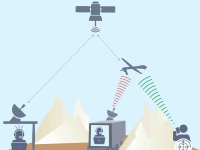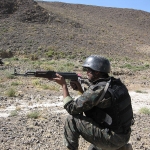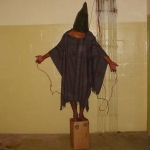Drone, Inc. - E: Relaying The Data

Data transmission problems have plagued the U.S. military since the start of the so-called “War on Terror,” not least because drones take up significantly more bandwidth than piloted planes. For example, just one Global Hawk drone, on average, requires five times as much bandwidth as the entire U.S. military did during the 1991 Gulf War. There simply aren’t enough government satellites to support this increase.74
In addition to dispatching near real-time surveillance video, for instance, drones must transmit video from the nose of the aircraft so that pilots on the other side of the world can control them. They must also send data like wind speed, location, and direction.
Two kinds of transmitters are mounted on the typical Predator or Reaper. The first operates in the C-band of the radio spectrum and is used by the Launch and Recovery Element (LRE) crew who control the aircraft as it takes off or lands at its local base—at Camp Lemonnier, Djibouti, for example, where drone operations over Somalia and Yemen are based.75 This C-band radio is limited to about 170 miles around the local base because it uses line-of-sight transmission.76
The LRE crew hands the drone over to a U.S.-based Mission Control Element (MCE) crew after takeoff and takes control back before landing.77 For this, the MCE crews rely on the second transmitter that communicates in the Ku-band of the radio spectrum via satellites. But the data takes about a second to travel from the U.S. to a drone over Yemen, so pilots must factor in the lag time, or “latency,” when sending commands to control the drone or fire its missiles.78
Drone bandwidth is measured the same way as internet connection speed: via the amount of data that can be transmitted per second. The original MTS-A sensor ball, for example, transmits analog-quality video that requires significantly less bandwidth—1-3 Mbps. The MTS-B, Raytheon’s second-generation sensor, captures video at higher resolutions that require a 3-10 Mbps connection.79
Ultimately data transmission depends on the same factors that determine how well a wireless internet connection works:
• Capacity, or how much data can be transmitted. This factor depends on both the speed a drone can upload and that a satellite can receive data. Older Milstar satellites provided a maximum of 1.5 Mbps throughput, which increased to 8.2 Mbps with the launch of the Advanced EHF satellites.80
• Congestion, or how much bandwidth is available at a given time. The principle is the same as when multiple users connect to a household WiFi router and start streaming movies, causing the connection speed for each user to deteriorate.
• Obstructions, such as rain, dust, lightning, and mountains can disrupt data transmission.
For an analyst to identify details like whether an individual is wielding an object the size of an AK-47 rifle, drones need to transmit video at 45 Mbps. Smaller weapons like pistols require a much higher data rate. (By comparison, in 2010, the peak year for drone strikes, the average U.S. home internet speed only 3.9 Mbps)81
To support the drone war, the military now relies on bandwidth from commercial providers like Eutelsat, Inmarsat, Intelsat, and SES Government Solutions which can steer satellites to provide spot beams of high-speed data on demand.82 Beginning February 24, 2012, the U.S. launched five new Lockheed Martin Mobile User Objective System (MUOS) military satellites to increase capacity.83
To overcome the mountainous topography in areas like Afghanistan, the U.S. also operates piloted aircraft such as Bombardier jets that fly in circles at 55,000 feet and above.84 These aircraft carry a Battlefield Airborne Communications Node (BACN), a data relay that can pick up weak transmissions from individual drones or ground troops and relay them to other users and to military bases in the local network.
< Previous • Report Index • Download Report • FAQ/Press Materials • Watch Video • Next >



